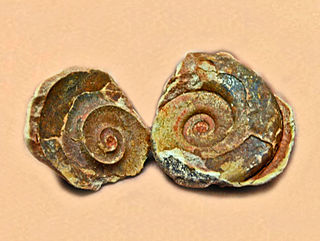The Treatise on Invertebrate Paleontology published by the Geological Society of America and the University of Kansas Press, is a definitive multi-authored work of some 50 volumes, written by more than 300 paleontologists, and covering every phylum, class, order, family, and genus of fossil and extant invertebrate animals. The prehistoric invertebrates are described as to their taxonomy, morphology, paleoecology, stratigraphic and paleogeographic range. However, taxa with no fossil record whatsoever have just a very brief listing.

Acanthohoplites is an extinct genus of ammonites in the family Parahoplitidae that lived in the Aptian and Early Albian stages of the Early Cretaceous.

Xenodiscus is an extinct ammonoid cephalopod genus and one of the earliest ceratites, found in the Upper Permian of northern India and Timor. Xenodiscus is included in the family Xenodiscidae which is part of the ceratite superfamily Xenodiscaceae
Albanites is a genus of extinct cephalopods belonging to the ammonoid order Ceratitida that lived during the Early Triassic.

The Xenodiscaceae is a superfamily within the ammonoid order Ceratitida. The Xenodiscaceae, named by Frech in 1902, presently contains ten families, only one of which was included in the original Otocerataceae of Hyatt, 1900, the remaining having been added.

Goniatitina is one of two suborders included in the order Goniatitida; extinct Paleozoic ammonoid cephalopods only distantly related to the Nautiloidea.
Cheiloceratidae is a family of ammonoid cephalopods included in the goniatitid suborder Tornoceratina in which the suture has 4 to 12 lobes, the ventral one undivided and those in the lateral areas originating as subdivisions of internal and external lateral saddles.
Tornoceratoidea, also known as Tornocerataceae, is a superfamily of goniatitid ammonoids included in the suborder Tornoceratina. Tornoceratoidea, or Tornocerataceae, is essentially the Cheilocerataceae of Miller, Furnish, and Schindewolf (1957) in the Treatise Part L, revised to accommodate new taxa and new perspectives on the phylogeny.
Tornoceratidae is a family of goniatitid ammonoids from the middle and upper Devonian. The family is included in the suborder Tornoceratina and the superfamily Tornoceratoidea.

Neoicoceratoidea, formerly called Neoicocerataceae, is one of seventeen superfamilies of the Goniatitina suborder. Neoicoceratoidea comprises forms previously included in the Neoioceratidae and Metalegoceratidae, previously included in the Goniatitacae. These, along with new families defined for certain genera, including one from the Schistoceratidae, have been recombined as the Neoicocerataceae.
Ancyloceratoidea, formerly Ancylocerataceae, is a superfamily of typically uncoiled and loosely coiled heteromorph ammonoids established by Alpheus Hyatt in 1900, that may contain as many as 11 families, depending on the classification accepted.

The Nautilaceae form one of five superfamilies that make up the Nautilida according to Bernard Kummel (1964), and the only one that survived past the Triassic. The Nautilaceae comprise six families: Nautilidae, Paracenoceratidae, Pseudonautilidae, Cymatoceratidae, Hercoglossidae, and Aturiidae. Shimanskiy (1957) separated the Paracenoceratidae and Pseudonautilidae from his near equivalent Nautilina and added them to the Lyroceratina, expanding the equivalent Clydonautilaceae and bringing it into the Jurassic. The Nautilaceae are represented by Nautilus and Allonautilus, genera included in the Nautilidae.

Stephanoceratoidea, formerly Stephanocerataceae, is a superfamily of middle- upper Jurassic ammonoid cephalopods within the order Ammonitida containing diverse forms, generally with sharp ribbing and complex suture lines. Aptychi are believed to be mostly granular (Granulaptycus) or concentrically ribbed on the surface (Praestriaptychus)

Acanthoceratoidea, formerly Acanthocerataceae, is a superfamily of Upper Cretaceous ammonoid cephalopods belonging to the order Ammonitida, and comprising some 10 or so families.
Longobarditidae is a family of ceratitd ammonoids known from the early Triassic, included in the Danubitaceae. Longobarditidae includes genera formerly placed in Hungaritidae by the American Treatise on Invertebrate Paleontology, Part L, 1957 as well as genera that have been described since.

Eoderoceratoidea is a superfamily of true ammonites from the Lower Jurassic, comprising seven phylogenetically related families, characterized in general by having ribbed evolute shells that commonly bear spines or tubercles. Adult shell size ranges from 2 or 3 cm to giants reaching 50 cm in such genera as Apoderoceras, Epideroceras, and Liparoceras.

Hildoceratidae is a family of ammonoid cephalopods from the Lower Jurassic, lower Pliensbachian to lower Bajocian substages, generally with strongly ribbed, involute shells. They are combined with the Hammatoceratidae, Graphoceratidae, and Sonniniidae to make up the Hildoceratoidea.

Ophiceras is a genus of smooth, evolute ceratitid ammonites from the Early Triassic, with a rounded venter. Fossils of the genus have been found in Armenia, Azerbaijan, China, Greenland, and India.
Meekoceras is a genus of ceratitid ammonites with a discoidal shell that lived during the Early Triassic Epoch.

Hammatoceratidae is a family of lower and middle Jurassic ammonites included in the superfamily Hildoceratoidea.











